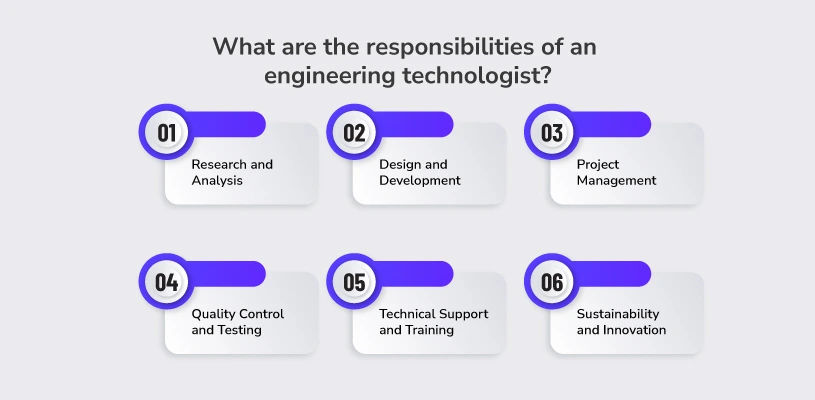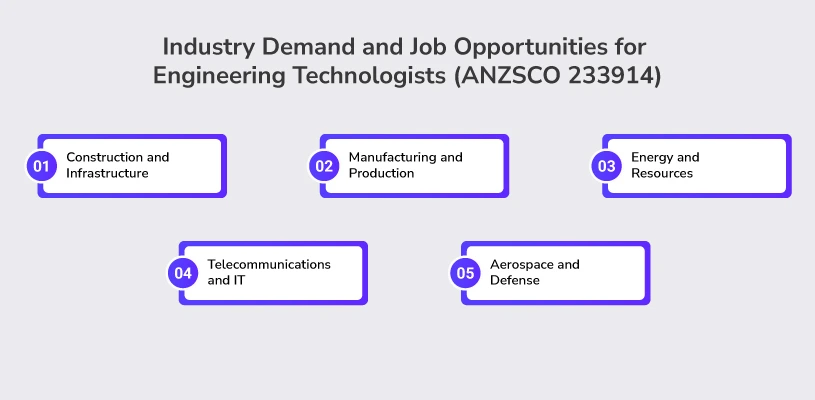
Engineering technologists function as vital professionals who connect engineering professionals and technical personnel in modern engineering practice. The membership code 233914 within the Australian and New Zealand Standard Classification of Occupations recognises engineering technologists through their ability to address practical engineering challenges by applying engineering principles and techniques.
The article examines engineering technologist functions along with educational prerequisites and task requirements while assessing career expectations in light of industry patterns together with career progression alternatives for professionals wanting Australian and New Zealand work opportunities.
Table of Contents
Who is an engineering technologist?
An engineering technologist functions as a professional who transforms engineering principles by focusing on direct practical usage rather than traditional engineering approaches.
Engineering technologists cooperate with engineers and technicians together with other industry professionals to implement technical innovations as well as solve design problems and deploy systems.
The core competency of engineering technologists revolves around implementing engineering solutions through practical hands-on management, even though they do not perform theoretical design tasks at high levels like engineers.
ANZSCO Code 233914: Engineering Technologist
Within the ANZSCO system, engineering technologists (233914) perform their professional duties according to the following definition:
Those who possess qualifications at level 1 can qualify for this role.
Engineering technologists apply current engineering technologies to various industries after reviewing and modifying them. Such professionals dedicate their efforts to enhancing designs along with processes and technological applications.
Specialisations:
- Aeronautical Engineering Technologist
- Agricultural Engineering Technologist
- Biomedical Engineering Technologist
- Civil Engineering Technologist
- Electrical Engineering Technologist
- Mechanical Engineering Technologist
- Structural Engineering Technologist
The work environment of an engineering technologist extends across manufacturing, construction, as well as aerospace, telecommunications, energy, and many other industrial sectors.
What are the responsibilities of an engineering technologist?

Engineers who work as technologists perform duties that adjust according to their industrial sector. However, some common duties include:
1. Research and Analysis
Engineers need to assess and evaluate existing engineering designs and systems.
An engineering technologist analyses technical specifications together with performance data for evaluation.
The evaluation of engineering solutions to overcome operational challenges forms part of their investigation process.
2. Design and Development
The role involves helping engineering staff create new technological solutions along with new products.
Engineers work to enhance and make better the current state of their engineering platforms.
Implementation of new solutions for industrial use.
3. Project Management
The engineer provides oversight to complete projects from their beginning phases through to their end.
The engineer serves to connect technical professionals with both stakeholders and team members for project coordination.
The project must pass tests that confirm compliance with safety regulations.
4. Quality Control and Testing
Both system inspections and testing equipment performance assessments are carried out as standard procedures.
The system adheres to regulatory standards together with the safety requirements of the industry.
Engineering projects require technical assessment and solutions to technical malfunctions.
5. Technical Support and Training
Engineers, together with technicians, receive support in technical aspects from the team.
The organisation trains its personnel in new engineering applications and technologies.
The creation of educational resources serves technical group members.
6. Sustainability and Innovation
Implementing environmentally friendly engineering solutions
Engineers must perform academic work to determine sustainable materials together with energy-efficient technologies.
Our company strives to improve efficiency through modern technology investments.
Industry Demand and Job Opportunities for Engineering Technologists (ANZSCO 233914)

Engineering technologists maintain critical roles throughout various Australian and New Zealand industrial sectors since they apply engineering concepts to advance and control technological solutions across multiple fields of operation.
Engineering technologists find their job demands continuously increase because both countries emphasise technological innovation and infrastructure development alongside renewable energy development and advanced manufacturing.
Engineers of technology provide critical support to various industries and have multiple available employment pathways, which we examine in detail.
1. Construction and Infrastructure
Construction and infrastructure development plans in Australia and New Zealand involve road and bridge building projects in addition to high-rise construction and transportation system installations and urban expansion works.
These projects depend on engineering technologists to maintain their quality standards and operational safety while improving their operational efficiency.
Job Roles in Construction and Infrastructure
- Engineering technologists specialising in structure design units carry out tests and implementations for buildings along with bridges and tunnels to guarantee safety and performance requirements.
- A civil engineering technologist supports civil engineers by evaluating designs while checking to meet regulatory requirements during road rail and urban infrastructure projects.
- Geotechnical Engineering Technologists carry out ground and soil analysis as their primary duty to establish stable foundations for structures.
2. Manufacturing and Production
The manufacturing sector of Australia and New Zealand is making its shift towards modern production systems that include automated processes, intelligent manufacturing, and high-tech platforms.
The workforce of engineering technologists stands essential to achieving production line optimisation as well as implementing new factory technologies combined with efficiency enhancements.
Job Roles in Manufacturing and Production
- A Mechanical Engineering Technologist specialises in enhancing machinery, tools, and mechanical systems that belong to the production line equipment.
- The Industrial Engineering Technologist optimises production processes, automates operations, and applies lean manufacturing techniques for better facility efficiency.
- A Biomedical engineering technologist supports the development as well as design of medical equipment and devices for clinical and hospital settings.
3. Energy and Resources
Australia leads worldwide in mining operations and produces oil, gas, and renewable energy on a global scale. The push towards sustainability along with environmental decarbonisation requires numerous engineers to develop sustainable and eco-friendly solutions, making their work highly demanded in the marketplace.
Job Roles in Energy and Resources
- Renewable Energy Technologists assist clean energy integration into power grids by developing projects that use solar, wind, and hydroelectric power systems.
- The Mining and Petroleum Engineering Technologist facilitates natural resource extraction while maintaining mining operations that protect both safety and environmental sustainability and operational efficiency.
- Specialising in power distribution and energy efficiency and smart grid technology permits electrical power technologists to manage electricity networks.
4. Telecommunications and IT
The arrival of 5G networks, IoT (Internet of Things), and AI-based automation has made telecommunications and IT key industries in the economy. Engineering technologists are essential to building, testing, and improving communication networks and smart technology systems.
Job Roles in Telecommunications and IT
- Network Engineering Technologist
Builds and maintains 5G and broadband networks to support reliable communication infrastructure.
- IoT Engineering Technologist
Knows how to connect smart sensors and devices across different industries.
- Automation and AI Technologist
Creates smart factory solutions and focuses on AI-powered predictive maintenance for industrial use.
5. Aerospace and Defense
Australia and New Zealand have growing aerospace and defence sectors, with more money going into military tech, space exploration, and aircraft making. Aircraft upkeep, avionic systems, and defence engineering solutions depend on engineering technologists.
Jobs Roles in Aerospace and Defense
- Aerospace Engineering Technologist
Develops aircraft, propulsion systems, and aerodynamics.
- Avionics Technologist
Works with aircraft electronic systems, including navigation and communication.
- Defence Systems Technologist
Creates military technology, including surveillance equipment, robots, and cyber defences.
Conclusion
Steep demand for engineering technologists (ANZSCO 233914) is being experienced in various sectors of the economy in Australia and New Zealand. Engineers of all types, such as mechanical, civil, and many others involved in the energy, telecommunication, and healthcare industries, will find that they are on the precipice of new developments because of the contributions made by engineering technologists.
However, as the infrastructure sector is growing, the use of green technologies, smart solutions, and the exploration of space are coming into focus. Also, through the use of technology and other facilities,job opportunities are widening and changing due to the demand for engineering technologists.
Specific job openings offered by various companies in IT, such as Mean Stack developers, DevOps engineers, UX/UI specialists, etc., are also carried out to convert them into the actual job roles aforementioned in the companies.
Technologies like artificial intelligence, machine learning, cloud technologies, and 5G have the potential to both create and eliminate job roles that will leave some occupations unaffected.
FAQs
1. Is an engineering technologist in demand in Australia?
Yes, engineering technologists are in high demand in Australia due to the country’s increasing infrastructure, renewable energy, and technology sectors.
2. What is the ANZSCO code for an engineering technologist?
The ANZSCO code for an engineering technologist is 233914, used for skilled migration, job classification, and visa applications in Australia and New Zealand.
3. What are the differences between an engineer and an engineering technologist?
Engineers focus on theoretical concepts, design, and advanced problem-solving, while engineering technologists implement these principles in practical, hands-on ways to function and improve existing technologies.
4. What is the role of an engineering technologist?
- Designing Systems
- Testing Solutions
- Managing Projects
- Bridging Theory and Practice
- Problem-solving
5. What are the highest-paying jobs in engineering technology?
These are some of the highest-paying jobs for engineering technology:
- Petroleum Engineering Technologist
- Electrical Engineering Technologist
- Aerospace Engineering Technologist
- Civil Engineering Technologist
- Environmental Engineering Technologist




